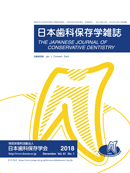Volume 61, Issue 5
Displaying 1-8 of 8 articles from this issue
- |<
- <
- 1
- >
- >|
Symposium in the Journal
-
2018 Volume 61 Issue 5 Pages 251
Published: 2018
Released on J-STAGE: October 31, 2018
Download PDF (150K) -
2018 Volume 61 Issue 5 Pages 252-257
Published: 2018
Released on J-STAGE: October 31, 2018
Download PDF (582K) -
2018 Volume 61 Issue 5 Pages 258-263
Published: 2018
Released on J-STAGE: October 31, 2018
Download PDF (1407K) -
2018 Volume 61 Issue 5 Pages 264-269
Published: 2018
Released on J-STAGE: October 31, 2018
Download PDF (909K)
Original Articles
-
2018 Volume 61 Issue 5 Pages 270-281
Published: 2018
Released on J-STAGE: October 31, 2018
Download PDF (2617K) -
2018 Volume 61 Issue 5 Pages 282-291
Published: 2018
Released on J-STAGE: October 31, 2018
Download PDF (879K) -
2018 Volume 61 Issue 5 Pages 292-304
Published: 2018
Released on J-STAGE: October 31, 2018
Download PDF (1036K) -
2018 Volume 61 Issue 5 Pages 305-315
Published: 2018
Released on J-STAGE: October 31, 2018
Download PDF (2793K)
- |<
- <
- 1
- >
- >|
